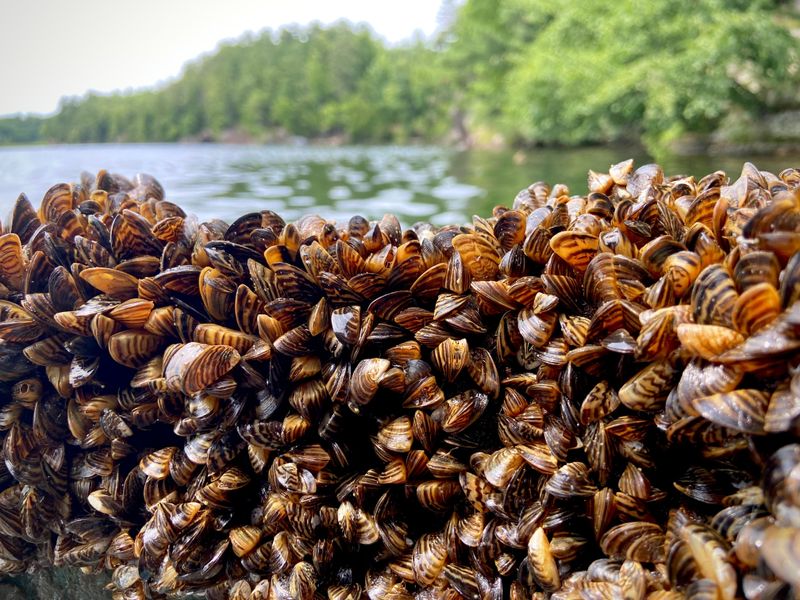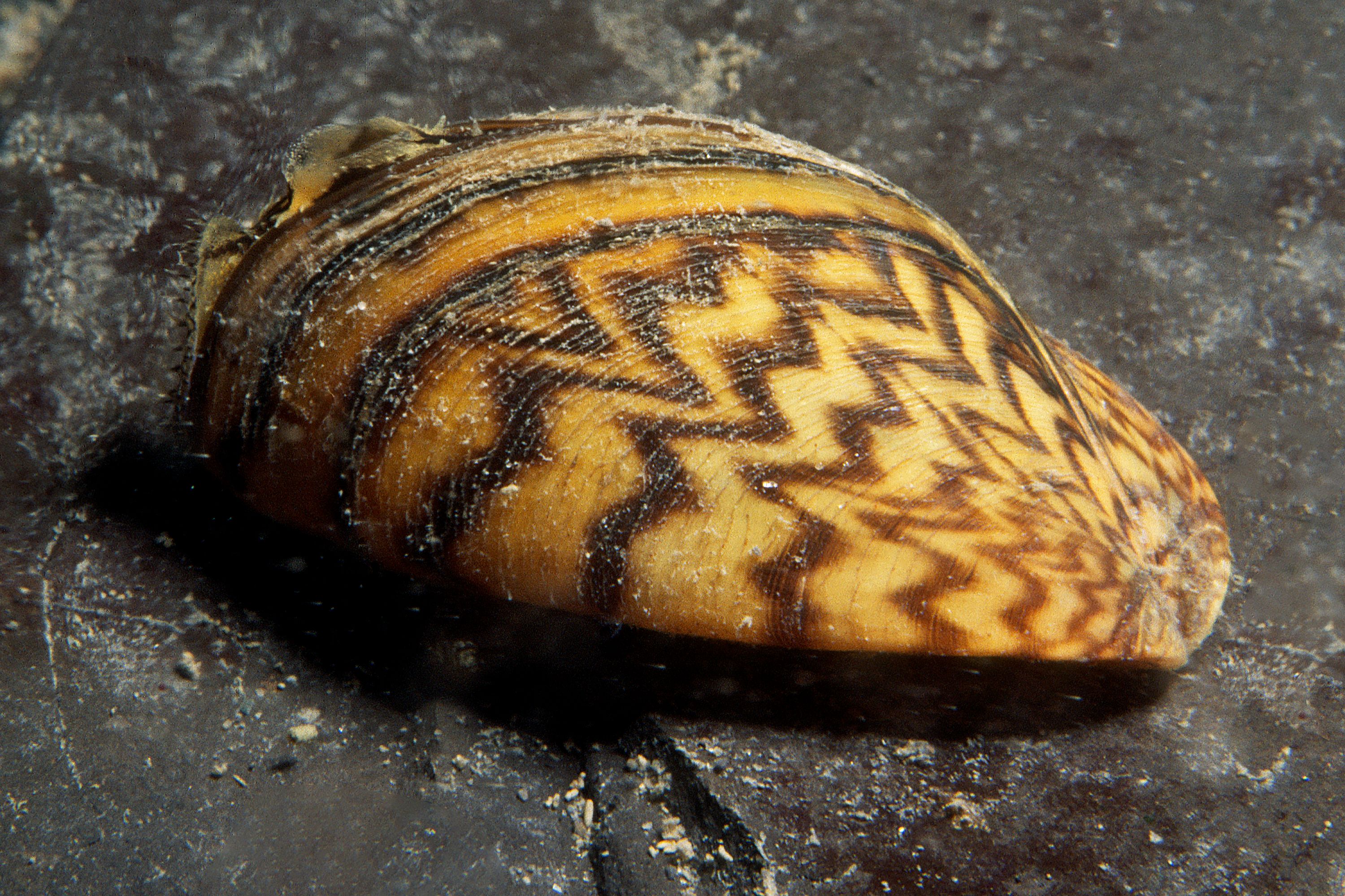Zebra Mussel

Species Details
Dreissena polymorpha
Dreissenidae
Venerida
Freshwater lakes, ponds, and rivers
0 - 0 lbs.
1" - 2"
Did You Know Zebra Mussels Are an Invasive Species?
Zebra mussels are considered an invasive species because they are non-native to many parts of North America and other regions, their introduction has caused significant ecological, economic, and environmental damage.
Zebra mussels are small, freshwater mollusks that have made a big impact. Native to Eastern Europe, these tiny creatures have become a global concern.
Their rapid reproduction and ability to colonize various surfaces have led to their spread across continents. They are now considered an invasive species in many parts of the world, including North America and Europe.
But what exactly are zebra mussels? And why should we be concerned about their presence in our water bodies?
This article aims to shed light on these questions. We will delve into the world of zebra mussels, exploring their habitat, diet, and distribution.
We will also uncover some shocking statistics about these creatures. And most importantly, we will discuss the significant impact they have on our ecosystems, economy, and even our daily lives.
What Are Zebra Mussels?
Zebra mussels are small, fingernail-sized bivalve mollusks. They are easily identified by their distinct striped shells, resembling the pattern of a zebra. This unique appearance makes them stand out, yet it is their impact that truly draws attention.
Originally from the lakes of Russia and Ukraine, zebra mussels have traveled far beyond their native lands. They were first discovered in North America's Great Lakes in the late 1980s. Since then, they have continued to spread across various water bodies.

These mussels attach to hard surfaces like boats and rocks, using strong threads called byssal fibers. Their ability to stick to many surfaces aids their widespread colonization. Zebra mussels are now found in numerous freshwater lakes, rivers, and canals worldwide.
Their preferred habitat includes waters with moderate temperatures and rich in calcium. Such conditions support their rapid growth and shell development. This adaptability makes them especially adept at invading new environments.
Zebra mussels reproduce at an astonishing rate. A single female can produce over a million eggs annually. This explosive reproduction contributes significantly to their classification as an invasive species.
Their presence disrupts local ecosystems and economies. In upcoming sections, we will explore how they achieve this, their diet, and their broader impact on the environment.
Zebra Mussel Distribution and Habitat
Zebra mussels have established themselves extensively beyond their origin. Their global distribution is vast, partly due to human activity. Shipping vessels have inadvertently assisted their spread across continents by discharging ballast water filled with zebra mussel larvae.
Once introduced to new waters, zebra mussels colonize rapidly. They latch onto various surfaces, from boats to natural stones. This behavior makes them highly mobile and versatile in their colonization efforts.
Freshwater ecosystems are particularly vulnerable to zebra mussels. They thrive in lakes and rivers with moderate temperatures. Calcium-rich waters provide the necessary components for shell growth, facilitating their expansion.
Below are some key factors about their habitat:
Prefer stable, freshwater bodies.
Survive in lakes, rivers, and canals.
Thrive in waters rich in calcium.
Adapt to moderate temperatures.
Often attach to hard surfaces.
These habitats allow zebra mussels to alter local ecosystems significantly. They consume large amounts of plankton and algae, which other species also rely on. As a result, they can outcompete native species for vital resources.
Their ability to thrive in diverse environments highlights their resilience. Understanding their habitat preferences is crucial for managing their spread and mitigating their impact. The next sections delve into how their diet further contributes to ecological changes.
The Diet of Zebra Mussels and Its Effects on Food Quality
Zebra mussels primarily feed on algae and plankton. They achieve this by filtering water through their gills. This feeding habit has profound implications for aquatic ecosystems.
By consuming large quantities of plankton, zebra mussels can alter local food webs. Native species that depend on these resources may struggle to survive. This competition can lead to the decline of certain fish populations.
The filtration activity of zebra mussels can clear up the water. While clearer water might seem beneficial, it can disrupt the ecological balance. Enhanced clarity allows sunlight to penetrate deeper, potentially causing excessive plant growth.
Algal blooms can be both beneficial and harmful. Some algae provide food, while others may produce toxins. By selectively consuming certain algal types, zebra mussels indirectly influence which species thrive.
Interestingly, zebra mussels can filter up to a liter of water per day. This statistic underscores their capability to affect water quality significantly. The alteration of food quality extends beyond nutrient levels, impacting aquatic plant growth and ecosystem dynamics.

While their filtering ability can improve certain water quality aspects, the broader environmental impact remains concerning. As zebra mussels continue to spread, understanding and managing their dietary habits become critical for maintaining ecological balance.
The Surprising Statistics of Zebra Mussel Proliferation
Zebra mussels have an astonishing ability to reproduce. A single female can produce over a million eggs in a year. This rapid reproduction rate is a key factor in their proliferation.
Their presence has dramatically altered ecosystems. For instance, they can filter up to one liter of water daily. This filtering capacity significantly affects water clarity and nutrient distribution.
Zebra mussels have expanded their range remarkably fast. Originating from Eastern Europe, they now inhabit much of North America and Europe. This widespread distribution underscores their invasive potential.
One shocking statistic about zebra mussels is their economic toll. In the United States alone, they cause billions in damages. These costs include repairs to water infrastructure and impacts on commercial industries. The relentless spread and ecological impacts of zebra mussels demand urgent attention and effective management strategies.
Zebra Mussels and Vegetation: An Unseen Battle Underwater
Zebra mussels dramatically alter aquatic plant communities. By filtering algae and plankton, they change the nutrient dynamics. This shift can decrease the available food for herbivorous fish.
As a result, zebra mussels often disrupt the delicate balance of underwater ecosystems. They compete with native species for both food and space. This competition can lead to declining populations of native aquatic plants.
Moreover, their presence can encourage excessive growth of certain aquatic plants. Increased water clarity allows more sunlight to reach deeper plant life. This can lead to an imbalance, with some plants thriving while others diminish.
The impact on vegetation extends to the broader ecosystem. Changes in plant diversity affect habitat availability for numerous species. Understanding these complex interactions is crucial for managing zebra mussel-infested waters.
Economic and Environmental Impact of Zebra Mussels
Zebra mussels have a profound economic impact. They cause extensive damage to water infrastructure. Clogged pipes and intake systems lead to costly repairs.
Industries relying on water systems face significant expenses. The maintenance burden increases, affecting operational budgets. This impact extends to hydroelectric plants and municipal water suppliers.
The environmental consequences are equally severe. Zebra mussels filter plankton, altering aquatic ecosystems. They disrupt local food webs, impacting native species.
Biodiversity loss is a significant concern. Native mussel populations often decline sharply. This loss affects the broader ecosystem stability.
Zebra mussels also influence water quality. They can increase water clarity, but this isn't always beneficial. Clearer water can lead to excessive plant growth.
Here's a brief list of key impacts:
Economic: increased maintenance costs, infrastructure damage
Ecological: biodiversity loss, ecosystem disruption
Water Quality: altered clarity, potential plant overgrowth
The impact on fisheries is also noteworthy. Altered ecosystems affect fish populations and commercial fishing. The knock-on effects can damage local economies.
Efforts to mitigate these impacts require significant resources. Without intervention, zebra mussels continue to spread unchecked. Coordinated management is essential to control their effects.
Infrastructure and Maintenance Costs
Zebra mussels attach to nearly any hard surface. This behavior leads to significant infrastructure damage. Water intake pipes are often choked by mussel accumulation.
Maintenance costs can skyrocket. Utilities and industries spend millions to remove mussels. Infrastructure repairs become a frequent necessity, straining budgets.
Hydroelectric power plants are notably affected. Mussel infestations reduce efficiency. Cleaning and preventive measures increase operational costs significantly.
Ecological Consequences and Biodiversity Loss
The ecological impact of zebra mussels is severe. They outcompete native species for resources. This leads to biodiversity declines, affecting whole ecosystems.
Native mussels suffer a shocking population drop. Zebra mussels blanket them, blocking their access to food. This can push endangered species closer to extinction.
The disruption isn't isolated. Cascading effects ripple through food webs. Loss of biodiversity weakens ecosystem resilience, leading to further ecological imbalances.
Recreational and Aesthetic Degradation
Zebra mussels also affect recreational activities. Their sharp shells can injure beach-goers. This hazard reduces the appeal of infested water bodies.
The aesthetic value of water bodies declines as well. Mussel infestations make otherwise attractive shores unsightly. This deters recreational use and diminishes enjoyment.
Managing the Zebra Mussel Threat
Managing zebra mussels requires proactive and strategic approaches. Their invasive nature makes them challenging to control. However, there are several strategies in place to mitigate their impact.
Public awareness is a crucial component. Educating boaters on proper cleaning methods helps prevent spread. Campaigns emphasize "Clean, Drain, Dry" protocols.
Prevention measures focus on maintaining boat and equipment hygiene. Limiting the transport of zebra mussels is essential. Awareness can significantly reduce new infestations.
Various control strategies are employed to manage existing populations. These include chemical, biological, and mechanical methods. Each approach has varying degrees of success and environmental impact.
Collaborative efforts between agencies enhance management success. Partnerships between local and federal bodies facilitate resource sharing. Joint initiatives support more comprehensive control efforts.
Here’s a list of key management strategies:
Public Education: raising awareness and educating boaters
Physical Removal: manual extraction and cleaning
Chemical Control: use of molluscicides where necessary
Biological Control: exploring natural predators and pathogens
Prevention and Control Strategies
Prevention is the most effective management strategy. By limiting the spread, new infestations are minimized. This includes strict regulation and enforcement.
Control measures must be tailored to local conditions. Effective strategies depend on the specific ecosystem. Chemical treatments, while effective, often require careful application.
Enhanced biosecurity measures help reduce mussel spread. These include decontamination stations at popular waterways. Clean water practices are promoted to all watercraft users.
Research and Technological Advances
Research plays a vital role in zebra mussel management. Scientists explore innovative solutions to control their populations. Current studies focus on environmentally friendly techniques.
Technological advances offer new hope. Methods like UV light treatment show promise. These approaches aim to reduce ecological disruption.
Continuous innovation is necessary to stay ahead. Research develops strategies for sustainable mussel control. Collaboration between scientists and policy makers is crucial for success.
Conclusion: The Intangible Effects of Zebra Mussels
Zebra mussels have become more than just an environmental nuisance. Their intangible effects ripple through ecosystems and human communities alike. While their presence brings certain visual changes, the less visible impacts are profound.
These tiny invaders alter biodiversity and water chemistry. Such shifts can reduce native species and alter ecosystems’ food webs. These changes are often overlooked but crucial.
Beyond the environment, zebra mussels influence economic and cultural aspects. Increased maintenance costs and recreational challenges frustrate communities. Understanding these unseen impacts emphasizes the need for continued vigilance and management. Proactive efforts remain essential to mitigate these multifaceted challenges.







